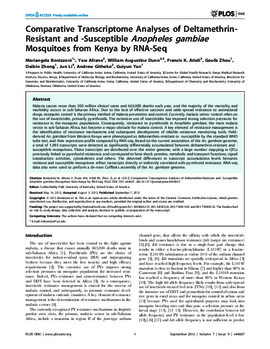| dc.contributor.author | Mariangela Bonizzoni | en_US |
| dc.contributor.author | Yaw Afrane | en_US |
| dc.contributor.author | William Augustine Dunn | en_US |
| dc.contributor.author | Francis K. Atieli | en_US |
| dc.contributor.author | Goufa Zhou | en_US |
| dc.contributor.author | Daibin Zhong | en_US |
| dc.contributor.author | Jun Li | en_US |
| dc.contributor.author | Andrew Githeko | en_US |
| dc.contributor.author | Guiyun Yan | en_US |
| dc.date.accessioned | 2015-01-23T17:17:40Z | |
| dc.date.accessioned | 2016-03-30T15:35:36Z | |
| dc.date.available | 2015-01-23T17:17:40Z | |
| dc.date.available | 2016-03-30T15:35:36Z | |
| dc.date.issued | 2012-09-07 | en_US |
| dc.identifier.citation | Bonizzoni M, Afrane Y, Dunn WA, Atieli FK, Zhou G, et al. (2012) Comparative Transcriptome Analyses of Deltamethrin-Resistant and -Susceptible Anopheles gambiae Mosquitoes from Kenya by RNA-Seq. PLoS ONE 7(9): e44607. doi:10.1371/journal.pone.0044607 | en_US |
| dc.identifier.uri | https://hdl.handle.net/11244/14080 | |
| dc.description | We are thankful to the reviewers for helpful comments. We thank Judith H. Willis for providing information on cuticular genes; Tian Zhen for helping in bioinformatics analyses; Osvaldo Marinotti, Anthony A. James and Joshua Hartsel for helpful discussions and the personnel of KERMI for mosquito collection and rearing. | en_US |
| dc.description | Conceived and designed the experiments: MB GY. Performed the experiments: MB GY YA FA DZ. Analyzed the data: MB WAD GZ JL. Contributed reagents/materials/analysis tools: AG YA FA. Wrote the paper: MB GY. | en_US |
| dc.description.abstract | Malaria causes more than 300 million clinical cases and 665,000 deaths each year, and the majority of the mortality and morbidity occurs in sub-Saharan Africa. Due to the lack of effective vaccines and wide-spread resistance to antimalarial drugs, mosquito control is the primary method of malaria prevention and control. Currently, malaria vector control relies on the use of insecticides, primarily pyrethroids. The extensive use of insecticides has imposed strong selection pressures for resistance in the mosquito populations. Consequently, resistance to pyrethroids in Anopheles gambiae, the main malaria vector in sub-Saharan Africa, has become a major obstacle for malaria control. A key element of resistance management is the identification of resistance mechanisms and subsequent development of reliable resistance monitoring tools. Field-derived An. gambiae from Western Kenya were phenotyped as deltamethrin-resistant or -susceptible by the standard WHO tube test, and their expression profile compared by RNA-seq. Based on the current annotation of the An. gambiae genome, a total of 1,093 transcripts were detected as significantly differentially accumulated between deltamethrin-resistant and -susceptible mosquitoes. These transcripts are distributed over the entire genome, with a large number mapping in QTLs previously linked to pyrethorid resistance, and correspond to heat-shock proteins, metabolic and transport functions, signal transduction activities, cytoskeleton and others. The detected differences in transcript accumulation levels between resistant and susceptible mosquitoes reflect transcripts directly or indirectly correlated with pyrethroid resistance. RNA-seq data also were used to perform a de-novo Cufflinks assembly of the An. gambiae genome. | en_US |
| dc.language.iso | en_US | en_US |
| dc.publisher | PLos One | en_US |
| dc.relation.ispartofseries | PLoS ONE 7(9):e44607 | en_US |
| dc.relation.uri | http://www.plosone.org/article/info%3Adoi%2F10.1371%2Fjournal.pone.0044607 | en_US |
| dc.rights | Attribution 3.0 United States | en_US |
| dc.rights.uri | https://creativecommons.org/licenses/by/3.0/us/ | en_US |
| dc.subject | PLOS | en_US |
| dc.subject | Public Library of Science | en_US |
| dc.subject | Open Access | en_US |
| dc.subject | Open-Access | en_US |
| dc.subject | Science | en_US |
| dc.subject | Medicine | en_US |
| dc.subject | Biology | en_US |
| dc.subject | Research | en_US |
| dc.subject | Peer-review | en_US |
| dc.subject | Inclusive | en_US |
| dc.subject | Interdisciplinary | en_US |
| dc.subject | Ante-disciplinary | en_US |
| dc.subject | Physics | en_US |
| dc.subject | Chemistry | en_US |
| dc.subject | Engineering | en_US |
| dc.title | Comparative Transcriptome Analyses of Deltamethrin-Resistant and -Susceptible Anopheles gambiae Mosquitoes from Kenya by RNA-Seq | en_US |
| dc.type | Research Article | en_US |
| dc.description.peerreview | Yes | en_US |
| dc.description.peerreviewnotes | http://www.plosone.org/static/editorial#peer | en_US |
| dc.identifier.doi | 10.1371/journal.pone.0044607 | en_US |
| dc.rights.requestable | false | en_US |

